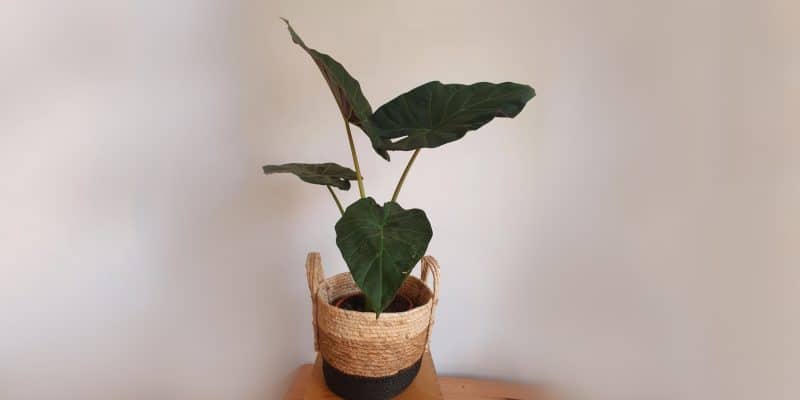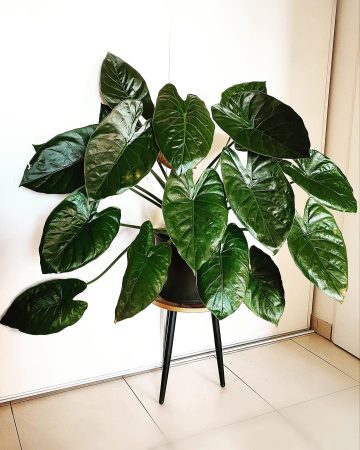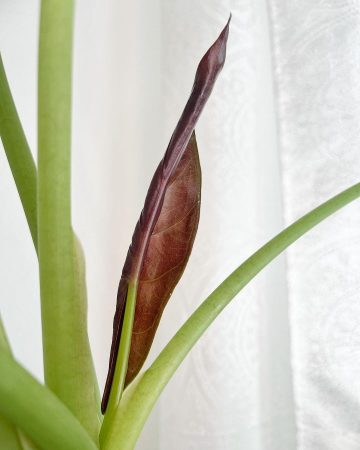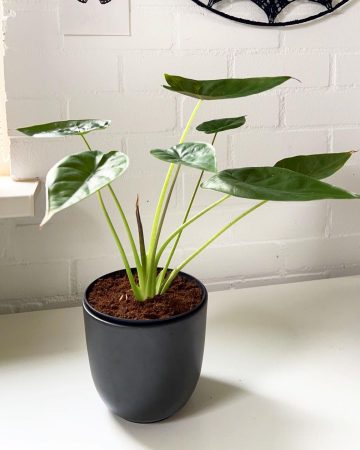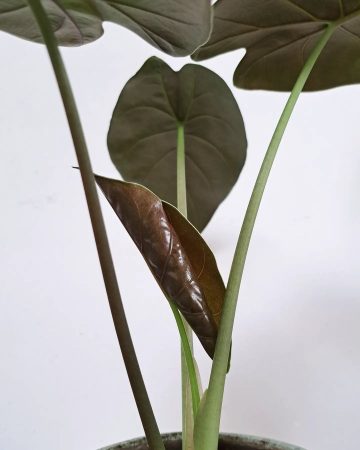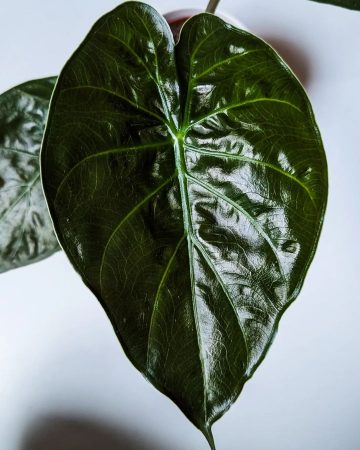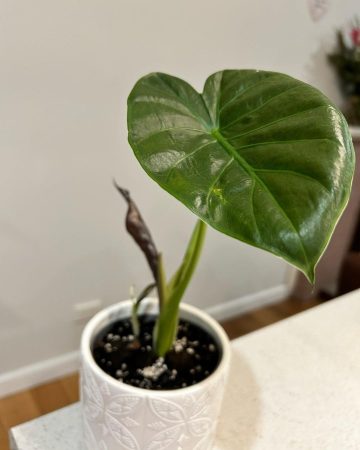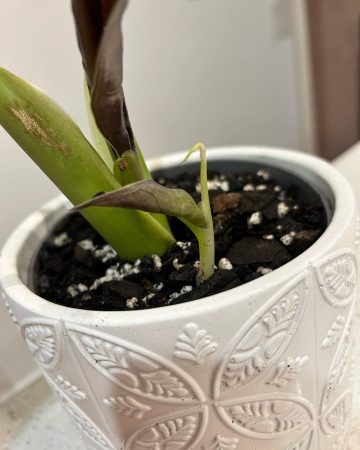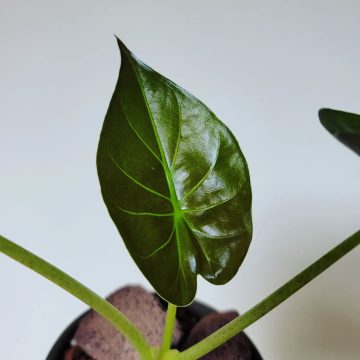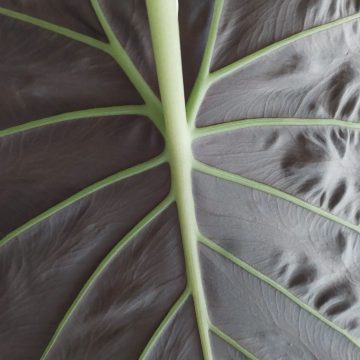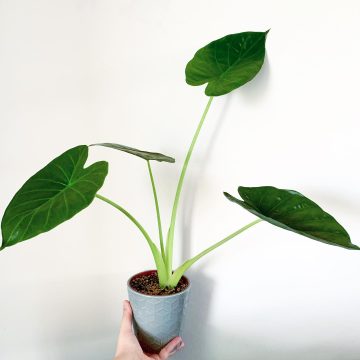Alocasia Wentii is a houseplant with an almost otherworldly charm. Its stunning, arrow-shaped leaves boast an alluring deep green hue on the top with a bold purple underside. It’s like having two plants in one!
Although it may seem exotic, Alocasia Wentii is surprisingly low-maintenance and adaptable.
In this Alocasia Wentii care guide, we’ll dive deep into everything from its history to the tips you need for it to thrive in your home garden.
Table of Contents
Alocasia Wentii Plant Care Guide
History, Habitat, and Characteristics
You know what they say about plants with big leaves like Alocasia Wentii – they’ve got big personality! This houseplant is as fun to grow as it is to pronounce. This stunning beauty, also known as the New Guinea Shield, is just the thing to transform your space into an exotic tropical oasis.
Believed to be a hybrid tropical plant, Alocasia Wentii is thought to have descended from a cross between Alocasia odora and Alocasia gageana. Alternatively, it may have been derived from an unknown purple-backed alocasia species. This botanical mystery adds an element of intrigue to this attractive plant.
Alocasia Wentii produces large, glossy leaves that are a sight to behold. The leaf fronts showcase a rich dark green hue, while the backs display a captivating bronze-purple color. And these leaves are not just pretty faces. Their large size allows the plant to capture sunlight more efficiently in its native tropical habitat, contributing to its adaptability and enduring appeal.
Under the right conditions, you might find a flowering Alocasia Wentii, but it hardly ever blooms inside. Plus, the foliage is the real star here. If you grow Alocasia Wentii outdoors in a subtropical climate, though, you’re likely to see flowers!
There’s also an Alocasia Wentii ‘Variegated’ (sometimes called ‘Silver Splash’) that has leaves dappled with cream and silver. Care for it will be the same, but it will need more light to maintain its variegation.
Whichever kind of Alocasia Wentii you’ve got, let’s jump into lighting next!
Light
Alocasia Wentii plants thrive in bright, indirect sunlight with a bit of partial shade, like the dappled sunspots shining through a tree canopy. If your plant isn’t getting enough light, you might notice slow growth and drooping Alocasia Wentii leaves. In this situation, your Alocasia is trying to tell you it needs a brighter home, ideally near an east or north-facing window.
On the flip side, too much direct light can cause the leaves to burn or turn an unhealthy yellow color. So basically, balance is key when it comes to lighting!
Lighting tips:
- Give your plant bright, indirect sunlight.
- Avoid direct light, which can burn those beautiful leaves.
- Adjust the location of your alocasia plant if you see signs of insufficient light.
- If natural light is limited in your space, consider using an LED grow light to supplement.
Water
Alocasia Wentii plants, also known as New Guinea Shield or Hardy Elephant Ear, need soil that’s evenly moist, not drenched or waterlogged. During warmer months, these tropical plants appreciate having their soil moist, while in colder months, they can tolerate somewhat dry soil. Try watering your Alocasia Wentii once a week, and let the plant’s soil dry out a bit before watering again.
Not enough water can cause the oldest leaves (usually at the bottom) to turn yellow and dry up, and some even curl inward. If you see these signs, consider increasing your watering frequency and be sure to remove any wilting leaves to prevent Alocasia Wentii pests like spider mites.
Excess water, on the other hand, leads to yellowing leaves and mushy stems. These symptoms might suggest root rot, a common plant condition that happens when you go overboard with water. To fix this, dial back your watering frequency.
Our watering tips:
- Water your Alocasia Wentii once a week when it’s warm outside, and less often in the cold months.
- Let the soil dry before watering again.
- Use filtered or distilled water if you can to avoid chemical buildup in the soil that can harm your plant.
Temperature and Humidity
Temperature: Alocasia Wentii (also known as New Guinea Shield or Purple Umbrella) prefers temperatures between 65-82°F, thriving when temperatures have minimal fluctuations. Extreme heat can harm the plant’s overall health.
Also, try to prevent exposure to cold drafts, keeping the plant away from frequently opened windows in the winter and air conditioners in the summer.
Humidity: Alocasia Wentii grows well in a humid environment, with a minimum of 60% humidity. Pay attention to the plant’s leaves; drooping or brown leaf tips may indicate that humidity levels are too low.
On the other hand, excessive humidity can lead to diseases or pests, so make sure not to overdo it. The right humidity conditions will promote healthy growth in your Alocasia Wentii.
Our tips:
- Maintain a consistent temperature between 65-82°F for your Alocasia Wentii plant, avoiding overheating or cold drafts.
- Aim for 60% humidity or higher, but avoid excessive humidity for alocasia plants.
- To increase indoor humidity, place a tray of water and pebbles beneath the plant or use a humidifier.
- Don’t mist Alocasia Wentii leaves directly. Instead, clean them with a moist cloth to remove dust and check for pests.
Soil and Planting
When it comes to Alocasia Wentii soil needs, choosing a high-quality soil that provides excellent drainage while retaining moisture is essential. Mixing in coconut coir, perlite, peat moss, and orchid bark can help improve the soil mix, for a thriving Alocasia Wentii plant.
If your Alocasia Wentii appears unhappy, it might be due to the wrong potting mix. Signs of poor soil conditions include yellowing leaves, stunted growth, and root rot.
To remedy this, carefully remove the Alocasia Wentii plant from its pot, inspect the root system for damage, and repot it, using a new well-draining soil mix. Be gentle during this process, as damaged roots can lead to additional plant stressors.
Fertilizer
During the growing season (spring and summer), use fertilizer to encourage and support new and existing growth of your Alocasia Wentii. Make sure to follow instructions and ease your plant into a fertilizing routine to avoid fertilizer burn, which can cause leaf tip browning and wilting.
If you suspect overfertilization, flush the plant’s soil with water several times to help leach out excess nutrients. Afterward, it’s essential to follow a less frequent fertilizing schedule and adhere to the recommended concentration.
If you notice symptoms such as burnt leaf tips, a pale or discolored appearance, or a leggy Alocasia Wentii plant, these are signs of too much fertilizer. To resolve this issue, remove your Alocasia Wentii from its pot, gently wash away excess fertilizer from the root system, and repot using fresh soil. Be sure to adjust your fertilizing routine to prevent future over-fertilizing issues.
Repotting
Repotting is another essential task for Alocasia Wentii care, and it’s best done during the growing season. Choose a container slightly larger than its current one and ensure it has proper drainage holes.
Carefully transfer the Alocasia Wentii plant into the new pot and surround the roots with the recommended soil mix, taking care not to compact the soil too much. This allows for proper aeration and drainage, which are crucial to the overall health of your Alocasia Wentii.
Propagation
One of the easiest ways to propagate your gorgeous Alocasia Wentii plant (Hardy Elephant Ear) is by division. It’s relatively painless and has a high success rate.
Propagating Alocasia Wentii by division:
- Gather your tools and set up your workspace: Grab a sharp knife or pruning shears, a container filled with water, a potting mix with coarse potting sand, and one or more pots for your soon-to-be propagated plants. Oh, and don’t forget to clean and sterilize your tools and workspace first to avoid any unwanted bacterial surprises.
- Reveal the tubers: Gently take your Alocasia Wentii out of its pot, trying not to harm the root system. Give the root ball a little shake to remove excess soil and reveal the hidden treasures (a.k.a. the tubers).
- Divide the tubers: With your clean knife or shears, carefully separate the Alocasia Wentii tubers. Each one should have at least one healthy growing point. If those tubers are playing hard to get, you can soak the root ball in water for a few minutes – it’ll make your life easier, we promise.
- Let the fresh cuts heal: Lay the divided tubers on a paper towel or tray, and allow the cut surfaces to air-dry for a few hours. This crucial step helps avoid infections or rot when we plant them.
- Plant your tuber divisions: Gently plant each tuber division in the new pots filled with fresh potting mix. Just remember to cover the tuber with soil and point the growing tip towards the sky. Give them a good drink of water and place them in a spot with bright, indirect light.
- Show your new plants some love: Keep the soil consistently moist but not soggy, and maintain humidity around your new Alocasia Wentii babies. As they grow, care for them the same way you do for the mother plant.
Our propagation tips:
- Patience is a virtue! Growing Alocasia Wentii can take a while as the plant settles in after the division. If you don’t see progress in a few weeks, that particular division might not have survived.
- Aim for propagating during spring or early summer, as the plant will be actively growing.
- Crank up the humidity by placing a humidity tray under the pots or by using a pebble tray filled with water. Your Alocasia plants will thank you for their tropical home away from home.
Common Issues
Dropping Leaves
So, your Alocasia Wentii plant is dropping leaves? Believe it or not, this is actually a normal part of this plant’s life cycle — especially during the winter months, when you have a dormant Alocasia Wentii or when new growth is popping up.
To identify leaf dropping, notice whether leaves are detaching from your Alocasia Wentii without any signs of decay. To care for Alocasia Wentii in this situation, make sure it’s getting enough light, humidity, and the right temperature. Boost humidity by misting those beautiful Alocasia leaves, or by placing the Wentii plant on a tray filled with pebbles and water. And remember, keep it away from cold drafts near windows and doors when the weather turns chilly.
Yellow Leaves
Now, if your Alocasia Wentii’s leaves are turning an odd yellowish color, too much direct sunlight might be the culprit. We don’t want our Alocasia plants blasted by sun rays all day long. Try to move your plant to a spot with bright, indirect light, or just use a sheer curtain to filter the sunshine intensity. Along with the right light, maintain consistent humidity levels and steady temperature so that your Alocasia Wentii’s leaves stay vibrant and green.
Melting Leaves
All right, this one can be a bit dramatic — your Alocasia Wentii might be experiencing something called “melting.” Imagine leaves that seem to vanish, leaving just the bulb and root behind (yikes!). But don’t worry, we’ll figure it out together.
Overwatering, poor soil drainage, or insufficient light can all cause this meltdown. To catch melting leaves early, look for any signs of disintegration or leaves breaking down. To fix this, let’s start with your watering schedule: we want to keep our Alocasia Wentii plant hydrated. Then, even if your Alocasia Wentii plant is in well-draining soil, you might even want to repot it with a fast-draining mix.
Lastly, ensure your plant is getting plenty of light and keep the temperature between a comfy 60-85°F.
Pests and Diseases
Spider Mites
If your Alocasia Wentii has some unwanted guests, they could be spider mites. These are tiny little pests that can make themselves at home on your beautiful New Guinea Shield plant. If you see webbing on the leaves and stems and you notice leaves are turning yellow and stippled, you’ve found your evidence. These small troublemakers feed on the sap of your plant, which can really weaken and damage your Alocasia Wentii.
Now, let’s tackle this issue! Start by moving your plant away from the others — we don’t want these mites throwing a party with your other plants. Next, use a damp cloth to gently wipe away webbing and spider mites from the leaves and stems. If those pesky mites won’t quit, you can use a miticide or neem oil, following the label instructions (we prefer neem oil).
To stop the little invaders from coming back, provide your Alocasia Wentii with good airflow and a consistent watering routine. It’s also a good idea to regularly wipe down your plant’s leaves with a damp cloth to retain moisture.
Root Rot
Root rot can be a real pain for many indoor plants, including Alocasia Wentii. This nasty problem creeps up when your New Guinea Shield’s roots are left sitting in wet soil for too long and they start to decay, turning slimy, brown, or black. If left untreated, root rot can send your beloved plant to an early grave.
But don’t worry, we can fix this! Carefully remove your Alocasia Wentii from its pot and cut away the rotten roots using sterilized scissors. If most of the roots are affected, you might need to propagate Alocasia Wentii and start fresh with a healthy section of the parent plant’s roots. Then it’s time to repot your plant in a pot with drainage holes and fresh, well-draining soil.
How do we stop root rot from rearing its ugly head again? Dial in your Alocasia Wentii watering needs: only water the plant when the top 1-2 inches of soil feel dry to the touch, and don’t let it sit in standing water (the roots don’t want to go for a swim!).
You can also add perlite or pumice to your soil mix for better aeration and drainage. Make it a habit to check your plant’s roots for any signs of rot, so you can nip the issue in the bud.
Conclusion
That’s all for our Alocasia Wentii care guide!
With its unique foliage and vibrant colors, this two-toned beauty truly stands out among other alocasia plants. Now that you’re armed with essential care tips, you can confidently grow and maintain a thriving Alocasia Wentii.
Alocasia Wentii care summary:
- Provide bright, indirect light and avoid direct light that can damage the leaves.
- Water your plant once a week during warmer months and less frequently during colder months. Allow the soil to dry between waterings.
- Use a well-draining soil mix, such as a blend of coconut coir, perlite, and orchid bark.
- Fertilize Alocasia Wentii during the growing season and repot when necessary to ensure a thriving plant.
- If you notice issues like dropping leaves, yellow leaves, melting leaves, or pests, address them promptly.
- We hope this guide helps you in your plant parenting journey, and if you have any questions or concerns about how to care for Alocasia Wentii, feel free to reach out to us on Facebook or Twitter. And don’t hesitate to share this guide with fellow plant lovers!
Take care, and happy planting!
FAQ
Is Alocasia Wentii toxic?
Alocasia Wentii is considered toxic to both humans and pets. It contains calcium oxalate crystals, which can cause irritation, swelling, and even difficulty swallowing if ingested. So, if you have curious kids, dogs, or cats roaming around, it’s best to keep this alluring beauty out of reach.
Is Alocasia Wentii rare?
While it might not be the rarest plant on the block, Alocasia Wentii certainly isn’t your average, everyday houseplant. Independent local nurseries usually sell it, but not big box ones as of yet. You can always rely on online shops like Etsy, too.
Also keep in mind that this plant might be termed “New Guinea Shield” instead, but rest assured, Alocasia Wentii is the same plant!
How tall does Alocasia Wentii grow?
Alocasia Wentii grow up to an impressive height of 3-4 feet! Its arrow-shaped leaves can grow to be around 12 inches long, creating a truly majestic display.

